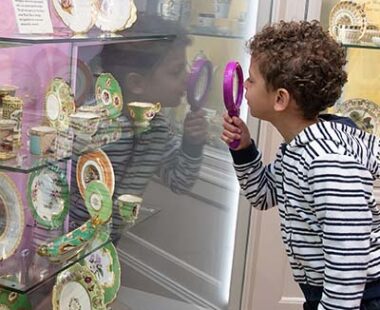By Rebecca Younger
London has many, many tales to tell, but just how far back does the history of this wonderful city go? Thanks to various archaeological digs around the River Thames which have uncovered spear heads and weapons from the Bronze and Iron Ages, it is thought that London’s first settlements date back to prehistoric times.
Reign of the Romans
However, it was the Romans who were responsible for the city we know today; after invading Britain in AD 43, they founded Londinium – a fort at the Thames crossing which was originally only about the size of Hyde Park. It is believed that the Roman army built its original river crossing close to Westminster but later replaced this with a sturdy wooden bridge, the remains of which have been excavated just east of London Bridge. For 1,600 years, this was the only crossing for the Thames.
The Romans reign in the city initially didn’t last long – just 17 years after they founded Londinium, Queen Boudica of the Norfolk Iceni tribe rose up against them and they fled west, leaving their burning city behind. Not ones to admit defeat, however, the Romans eventually returned and regained control, rebuilding London with a city wall around it to protect it from further invasion, along with a market and basilica. The area inside this wall is known today as ‘The Square Mile’ or ‘The City’, and remains the financial centre of the UK.
This rebirth was the start of a golden age of trade and by AD 100 vast quantities of goods from across the empire were changing hands at Londinium including wine and pottery from Gaul and Italy, olive oil from Spain, marble from Greece and, of course, slaves. There was also a thriving export market for copper, tin, silver and corn.

By AD 100 vast quantities of goods from across the empire were changing hands at Londinium thanks to its position on the River Thames
The Romans left at the beginning of the 5th century as the Roman Empire crumbled, leaving London largely deserted. Britain was invaded by the Angles, the Saxons and the Jutes but as farmers they preferred to live outside big towns and so little is known about London in this period.
However, by the beginning of the 7th century the city had become important enough to justify the building of a cathedral, St Paul’s, at the highest point in the city – believed to be the same spot where our current St Paul’s Cathedral stands today.
During the 9th century Londinium was renamed Lundenburh and the area west, which the Romans fled to during Queen Boudica’s uprising, was referred to as Ealdwic, meaning old town. This is where the present district of ‘Aldwych’ gets its name.
It is believed that the Roman army built its original river crossing close to Westminster but later replaced this with a sturdy wooden bridge, the remains of which have been excavated just east of London Bridge
Historic landmarks
It was after one of England’s most famous invasions that one of the city’s most famous landmarks was built. In 1066 the Normans invaded England from France and William the Conqueror took control of the city, quickly building the Tower of London as its military stronghold.
During its lifetime, The Tower has been used as a castle and a palace, a zoo and a weapons store, a mint and a prison and today is classed as a UNESCO World Heritage Site thanks to its fascinating past. The Tower is most famous, however, for being a prison and the place where traitors, such as King Henry’s wife Queen Anne Boleyn, were beheaded. During Tudor times, the many prisoners were brought to the tower by river through Traitor’s Gate.
- Today you can see the Crown Jewels at the Tower of London
- Traitor’s Gate
From one remaining historic landmark to another, the first permanent stone River Thames crossing which was commissioned by Henry II in 1176. Before that the only way to cross the Thames from London on the north bank to the southern suburb of Southwark was by ferry or a rickety wooden bridge. It took 33 years to complete and was to last more than 600 years – it is today known as London Bridge.
Crossing the medieval London Bridge often took over an hour, which gave its users plenty of time to view the heads of traitors on spikes above the bridge’s stone gatehouses. The first unfortunate person to have his tar-soaked head displayed in this manner was Scottish freedom fighter William Wallace, in 1305. The practice continued until 1678 and included the heads of Thomas More, Guy Fawkes and Oliver Cromwell.
The Tower is most famous, however, for being a prison and the place where traitors, such as King Henry’s wife Queen Anne Boleyn, were beheaded
Medieval traditions
London continued to grow within its original Roman walls throughout medieval times – the locations of the gates through which people entered and left the city are still marked today with street names such as Bishopsgate and Moorgate. In fact, if you look today in the area known as the Square Mile, there is plenty of evidence of medieval London in the street names, which tell of the trades and the shops established during that time, such as Pudding Lane, Milk Street, Ropemakers Square and Silk Street.
Another place where London’s prisoners sentenced to death met their very public end was at Tyburn Tree, London’s infamous gallows. You wouldn’t know the site existed today apart from the stone plaque, which sits in the ground on one of the traffic islands at the junction of Marble Arch and Edgware Road.
The huge triangular Tyburn Tree, erected in 1571 and made of thick wooden 3m crossbeams on 5.5m legs, played a part in an estimated 50,000 hangings. Mass executions took place on Mondays, when prisoners were transported in their finest clothes from Newgate Prison to Tyburn in an open wagon. The hangings were witnessed by thousands of spectators, who would pay to sit in open galleries erected especially for the occasion or rent the upper-storey rooms of the houses and pubs facing the site.

In 1625, Charles I brought his court to Richmond Palace and turned it into a park for red and fallow deer
Just around the corner from the site, at 8 Hyde Park Place, you can still find Tyburn Convent, which was founded at the beginning of the 20th century and contains a Shrine of the Martyrs in remembrance of more than 350 Catholics who died at Tyburn during the Reformation.
In Tudor times London became the centre of trade and government and by the end of the era there were about 200,000 people living both inside the city walls and in the nearby town of Westminster, on the north side of the River Thames, and Southwark, on the south.
Most of London as we know it today was still fields but the Tudors established a number of palaces in London and surrounding area, such as King Henry VIII’s Richmond Palace. They also created deer parks so that they could indulge in their favourite occupation of hunting. Later, in 1625, Charles I brought his court to Richmond Palace and turned it into a park for red and fallow deer – deer can still be seen at what we know as Richmond Park today.
Another place where London’s prisoners sentenced to death met their very public end was at Tyburn Tree, London’s infamous gallows
Dramatic events
The first theatres were also built in London during this time; the most famous being The Globe, which was partly owned by William Shakespeare. The original theatre burnt down in 1613 and was immediately rebuilt, but closed by the Puritans in 1642. In the 1990s a new Globe Theatre was built just a few hundred yards from the original theatre and today it thrives with regular productions of Shakespeare plays.
The 17th century was a time of huge change – and indeed drama – for London. At the start of the century, the gunpowder plot almost saw the Houses of Parliament blown up and by the 1640s civil war raged throughout England, with King Charles I and battling against Oliver Cromwell and Parliament. The King lost and was beheaded in London in 1649.
- St Pancras Church was destroyed in the Great Fire of London
- Shakespeare’s Globe
Sixteen years later and the last ever major epidemic of the bubonic plague in England rampaged through the city, killing 100,000 people. Brought to the city by rats on board trading ships, the Great Plague lasted a whole year and was almost certainly a death sentence if you caught it – 60 to 80 per cent of those who did, died. A red cross was painted on the front door of the houses of those infected and everyone inside was isolated for 40 days.
While the plague had little effect on London’s buildings, the 1666 Great Fire of London wiped out 80 per cent of the city. On 2nd September, a small fire, which accidentally started in Pudding Lane, spread into an enormous blaze lasting four days.
Astonishingly, very few people lost their lives, but because London’s buildings were crammed so closely together, and were made of wood, they were easily destroyed. By the time it burned out on 5th September around 13,000 buildings had been destroyed, including the original St Paul’s Cathedral, 87 parish churches, the Guildhall and the Royal Exchange, while up to 80,000 people lost their homes.
Brought to the city by rats on board trading ships, the Great Plague lasted a whole year and was almost certainly a death sentence if you caught it – 60 to 80 per cent of those who did, died
Rebuilding the capital
The task of getting London rebuilt was given to a committee of six men, including architect Christopher Wren. Their role was to manage surveys of ruined properties and consider the form and scale of new buildings, and any alterations to the streets. It was a mammoth project estimated to cost more than £10 million. A monument to the Great Fire stands on the corner of Monument Street and Fish Street Hill and is positioned so that if it fell over in the right direction, it would point to the exact place where the fire started.
In the 1700s London became an important financial centre with much of the business done in coffee houses in The Square Mile, especially in Exchange Alley, the site of London’s stock exchange today. London’s growth into the centre of world trade flourished during Queen Victoria’s reign when railways were built linking much of Britain to the capital. Many of the buildings in London today were also built during Victorian times, the most famous being the Houses of Parliament, which were built in 1834 after a fire destroyed the original buildings.

In 1668, Christopher Wren began reconstruction of St Paul’s Cathedral which was destroyed in the Great Fire
It was also during the Victorian era that the first ever underground railway opened, in 1863, running between Paddington (then called Bishop’s Road) and Farringdon Street. The first complete line – the Circle Line – was opened 21 years later and by the end of the century, in 1890, London launched the world’s first deep-level electric railway.
London continued to grow in population and geographical spread during the 20th century. In fact during the two decades between 1919 and 1939 it doubled in size. In 1915, advertisers coined the phrase ‘Metro-land’, painting a picture of rural charm within easy reach of the city to entice people to settle in London’s suburbs and new estates were developed in areas such as Neasden, Wembley Park, Northwick Park, Eastcote, Rayners Lane, Ruislip, Hillingdon, Pinner, Rickmansworth and Amersham – it was the beginning of London’s urban sprawl.
Many of the buildings in London today were also built during Victorian times, the most famous being the Houses of Parliament, which were built in 1834 after a fire destroyed the original buildings
Modernisation
During the Second World War, however, many of London’s building’s were badly damaged, particularly in the area surrounding St Paul’s Cathedral – these days you can identify the places the bombs hit where a more modern building has been built in between and surrounded by Victorian ones.
The most notorious raid took place on Sunday, 29th December, where the area from Aldersgate to Cannon Street and Cheapside to Moorgate went up in flames with 19 churches, including 16 built by Christopher Wren after the Great Fire of London, destroyed. Miraculously, St Paul’s survived. In the end around one third of the city was destroyed, although many of the main business streets, such as Cornhill and Lombard Street suffered little damage and the Bank of England and the Stock Market were not hit.

The Shard made history as Western Europe’s tallest building when it was built in 2013
The end of the century was marked by the construction of another iconic landmark on the bank of the River Thames. The Millennium Wheel, or London Eye as it is known today, is now one of the most popular tourist attractions in the capital. And, for a snapshot of the history of London, head to the London Bridge Experience where you can see, hear and even smell what the Bridge and the wider city was like through the ages.
London continues to literally build on its history and in 2012 hosted the London Olympics for the third time. With it came a brand new ‘village’, Queen Elizabeth Park, and then in 2013 The Shard – western Europe’s tallest building – opened its doors next to London Bridge Station.
Read more about London















